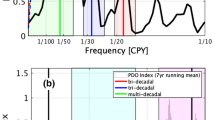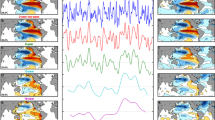Abstract
A new index is developed for the Interdecadal Pacific Oscillation, termed the IPO Tripole Index (TPI). The IPO is associated with a distinct ‘tripole’ pattern of sea surface temperature anomalies (SSTA), with three large centres of action and variations on decadal timescales, evident in the second principal component (PC) of low-pass filtered global SST. The new index is based on the difference between the SSTA averaged over the central equatorial Pacific and the average of the SSTA in the Northwest and Southwest Pacific. The TPI is an easily calculated, non-PC-based index for tracking decadal SST variability associated with the IPO. The TPI time series bears a close resemblance to previously published PC-based indices and has the advantages of being simpler to compute and more consistent with indices used to track the El Niño–Southern Oscillation (ENSO), such as Niño 3.4. The TPI also provides a simple metric in physical units of °C for evaluating decadal and interdecadal variability of SST fields in a straightforward manner, and can be used to evaluate the skill of dynamical decadal prediction systems. Composites of SST and mean sea level pressure anomalies reveal that the IPO has maintained a broadly stable structure across the seven most recent positive and negative epochs that occurred during 1870–2013. The TPI is shown to be a robust and stable representation of the IPO phenomenon in instrumental records, with relatively more variance in decadal than shorter timescales compared to Niño 3.4, due to the explicit inclusion of off-equatorial SST variability associated with the IPO.







Similar content being viewed by others
References
Andreoli RV, Kayano MT (2005) ENSO-related rainfall anomalies in South America and associated circulation features during warm and cold Pacific decadal oscillation regimes. Int J Climatol 25(15):2017–2030
Arblaster JM, Meehl GA, Moore AM (2002) Interdecadal modulation of Australian rainfall. Clim Dyn 18(6):519–531
Biondi F, Gershunov A, Cayan DR (2001) North Pacific decadal climate variability since 1661. J Clim 14:5–10
Cai W, van Rensch P (2012) The 2011 southeast Queensland extreme summer rainfall: a confirmation of a negative Pacific Decadal Oscillation phase? Geophys Res Lett 39(8):L08702
Cai W, Whetton P (2001) Modes of SST variability and the fluctuation of global mean temperature. Clim Dyn 17(11):889–901
Christensen JH et al (2013) Climate phenomena and their relevance for future regional climate change. In: Stocker TF et al (eds) Climate change 2013: the physical science basis. Contribution of working group I to the fifth assessment report of the intergovernmental panel on climate change. Cambridge University Press, Cambridge, pp 1217–1308
Compo GP et al (2011) The twentieth century reanalysis project. Q J R Meteorol Soc 137(654):1–28
D’Arrigo R, Wilson R (2006) On the Asian expression of the PDO. Int J Climatol 26(12):1607–1617
Deser C, Phillips AS, Hurrell JW (2004) Pacific interdecadal climate variability: linkages between the tropics and the North Pacific during boreal winter since 1900. J Clim 1900:3109–3124
Deser C et al (2010) Sea surface temperature variability: patterns and mechanisms. Ann Rev Mar Sci 2:115–143
England MH et al (2014) Recent intensification of wind-driven circulation in the Pacific and the ongoing warming hiatus. Nat Clim Change 4(3):222–227
Folland CK et al (2002) Relative influences of the Interdecadal Pacific Oscillation and ENSO on the South Pacific Convergence Zone. Geophys Res Lett 29(13)
Folland CK, Salinger MJ (1995) Surface temperature trends and variations in New Zealand and the surrounding ocean, 1871–1993. Int J Climatol 15:1195–1218
Folland CK et al (1999) Large scale modes of ocean surface temperature since the late nineteenth century. In: Navarra A (ed) Beyond El Nino: decadal and interdecadal climate variability. Springer, New York, pp 73–102
Folland CK et al (2003) Trends and variations in South Pacific island and ocean surface temperatures. J Clim 16(1995):2859–2874
Folland CK et al (2013) High predictive skill of global surface temperature a year ahead. Geophys Res Lett 40(4):761–767
Gallant AJE et al (2013) Nonstationary Australasian teleconnections and implications for paleoclimate reconstructions. J Clim 26(22):8827–8849
Gergis J et al (2012) On the long-term context of the 1997–2009 “Big Dry” in South-Eastern Australia: insights from a 206-year multi-proxy rainfall reconstruction. Clim Change 111:923–944
Gershunov A, Barnett TP (1998) Interdecadal modulation of ENSO teleconnections. Bull Am Meteorol Soc 79(12):2715–2725
Gershunov A, Cayan D (2003) Heavy daily precipitation frequency over the contiguous United States: sources of climatic variability and seasonal predictability. J Clim 16:2752–2765
Hamlet AF, Lettenmaier DP (2007) Effects of 20th century warming and climate variability on flood risk in the western U.S. Water Resour Res 43(6):W06427
Hartmann DL et al (2013) Observations: atmosphere and surface. In: Stocker TF et al (eds) Climate change 2013: the physical science basis. Contribution of working group I to the fifth assessment report of the intergovernmental panel on climate change. Cambridge University Press, Cambridge, pp 159–254
Henley BJ et al (2011) Climate-informed stochastic hydrological modeling: incorporating decadal-scale variability using paleo data. Water Resour Res 47(11):W11509
Henley BJ, Thyer MA, Kuczera G (2013) Climate driver informed short-term drought risk evaluation. Water Resour Res 49(5):2317–2326
Ilin A, Kaplan A (2009) Bayesian PCA for reconstruction of historical sea surface temperatures. In: Proceedings of the international joint conference on neural networks (IJCNN 2009). Atlanta, USA, pp 1322–1327
Jolliffe IT (2002) Principal component analysis, 2nd edn. Springer, New York
Karspeck AR, Kaplan A, Sain SR (2011) Bayesian modelling and ensemble reconstruction of mid-scale spatial variability in North Atlantic sea-surface temperatures for 1850–2008. Q J R Meteorol Soc 138:234–248
Kennedy JJ et al (2011a) Reassessing biases and other uncertainties in sea surface temperature observations measured in situ since 1850: 1. Measurement and sampling uncertainties. J Geophys Res 116(D14):D14103
Kennedy JJ et al (2011b) Reassessing biases and other uncertainties in sea surface temperature observations measured in situ since 1850: 2. Biases and homogenization. J Geophys Res 116(D14):D14104
Kennedy JJ et al (2015) The Met Office Hadley Centre sea ice and sea-surface temperature data set, version 2: 2. Sea-surface temperature analysis (in preparation)
Kiem AS, Franks SW, Kuczera G (2003) Multi-decadal variability of flood risk. Geophys Res Lett 30(2):1035
King AD, Alexander LV, Donat MG (2013) Asymmetry in the response of eastern Australia extreme rainfall to low-frequency Pacific variability. Geophys Res Lett 40(10):2271–2277
Kirtman B et al (2013) Near-term climate change: projections and predictability. In: Stocker TF et al (eds) Climate change 2013: the physical science basis. Contribution of working group I to the fifth assessment report of the intergovernmental panel on climate change. Cambridge University Press, Cambridge, pp 953–1028
Linsley BK et al (2008) Interdecadal-decadal climate variability from multicoral oxygen isotope records in the South Pacific Convergence Zone region since 1650 AD. Paleoceanography 23(2):PA2219
Luo J-J, Sasaki W, Masumoto Y (2012) Indian Ocean warming modulates Pacific climate change. Proc Natl Acad Sci USA 109(46):18701–18706
Mantua NJ, Hare SR (2002) The pacific decadal oscillation. J Oceanogr 58(1):35–44
Mantua NJ et al (1997) A Pacific interdecadal climate oscillation with impacts on salmon production. Bull Am Meteorol Soc 78(January):1069–1079
McCabe GJ, Dettinger MD (1999) Decadal variations in the strength of ENSO teleconnections with precipitation in the western United States. Int J Climatol 19(13):1399–1410
McGregor S et al (2014) Recent Walker circulation strengthening and Pacific cooling amplified by Atlantic warming. Nat Clim Change 4(10):888–892
McPhaden MJ, Zhang D (2004) Pacific Ocean circulation rebounds. Geophys Res Lett 31(18):L18301
Meehl G, Hu A (2006) Megadroughts in the Indian monsoon region and southwest North America and a mechanism for associated multidecadal Pacific sea surface temperature anomalies. J Clim 19(9):1605–1623
Meehl GA, Hu A, Tebaldi C (2010) Decadal prediction in the Pacific region. J Clim 23(11):2959–2973
Meehl G et al (2013) Externally forced and internally generated decadal climate variability associated with the Interdecadal Pacific Oscillation. J Clim 26(18):7298–7310
Micevski T, Franks SW, Kuczera G (2006) Multidecadal variability in coastal eastern Australian flood data. J Hydrol 327(1–2):219–225
Morice CP et al (2012) Quantifying uncertainties in global and regional temperature change using an ensemble of observational estimates: the HadCRUT4 data set. J Geophys Res 117(D8):D08101
Newman M, Compo GP, Alexander MA (2003) ENSO-forced variability of the Pacific decadal oscillation. J Clim 16(23):3853–3857
Parker DE, Folland CK, Jackson M (1995) Marine surface temperature: observed variations and data requirements. Clim Change 31(2–4):559–600
Parker D et al (2007) Decadal to multidecadal variability and the climate change background. J Geophys Res 112(D18):D18115
Power S, Colman R (2006) Multi-year predictability in a coupled general circulation model. Clim Dyn 26(2–3):247–272
Power S et al (1998) Australian temperature, Australian rainfall and the Southern Oscillation, 1910–1992: coherent variability and recent changes. Aust Meteorol Mag 47(2):85–101
Power S et al (1999) Inter-decadal modulation of the impact of ENSO on Australia. Clim Dyn 15(5):319–324
Pui A, Lal A, Sharma A (2011) How does the Interdecadal Pacific Oscillation affect design floods in Australia? Water Resour Res 47:W05554
Qian C, Zhou T (2014) Multidecadal variability of North China aridity and its relationship to PDO during 1900–2010. J Clim 27(3):1210–1222
Rayner NA et al (2003) Global analyses of sea surface temperature, sea ice, and night marine air temperature since the late nineteenth century. J Geophys Res Atmos 108(D14):4407
Rayner NA et al (2006) Improved analyses of changes and uncertainties in sea surface temperature measured in situ sice the mid-nineteenth century: the HadSST2 dataset. J Clim 19(3):446–469
Rayner NA et al (2015) The Met Office Hadley Centre sea ice and sea-surface temperature data set, version 2: 3. The combined analysis (in preparation)
Salinger MJ, Renwick JA, Mullan AB (2001) Interdecadal Pacific Oscillation and South Pacific climate. Int J Climatol 21:1705–1721
Salinger MJ et al (2014) A new index for variations in the position of the South Pacific convergence zone 1910/11–2011/2012. Clim Dyn 43(3–4):881–892
Schneider N, Cornuelle B (2005) The forcing of the Pacific decadal oscillation. J Clim 18:4355–4373
Smith TM et al (2008) Improvements to NOAA’s historical merged land-ocean surface temperature analysis (1880–2006). J Clim 21(10):2283–2296
Stewart I, Cayan D, Dettinger M (2005) Changes toward earlier streamflow timing across western North America. J Clim 18:1136–1155
Verdon DC et al (2004) Multidecadal variability of rainfall and streamflow: eastern Australia. Water Resour Res 40(10):W10201
Wang L, Chen W, Huang R (2008) Interdecadal modulation of PDO on the impact of ENSO on the east Asian winter monsoon. Geophys Res Lett 35(20):L20702
Wang S et al (2014) Combined effects of the Pacific decadal oscillation and El Niño–Southern oscillation on global land dry-wet changes. Sci Rep 4:6651
Zhang Y, Wallace JM, Battisti DS (1997) ENSO-like interdecadal variability: 1900-93. J Clim 10(5):1004–1020
Acknowledgments
BH is supported by the Australian Research Council under a Cooperative Research Network (CRN) fellowship. JG is supported by an Australian Research Council DECRA fellowship DE130100668, and DK is supported by the Australian Research Council Centre of Excellence for Climate System Science. SBP is supported by the Australian Department of the Environment through the Australian Climate Change Science Program. JK and CKF are supported by the Joint UK DECC/Defra Met Office Hadley Centre Climate Programme (GA01101). The TPI is available at: www.esrl.noaa.gov/psd/data/climateindices/list/.
Author information
Authors and Affiliations
Corresponding author
Electronic supplementary material
Below is the link to the electronic supplementary material.
Rights and permissions
About this article
Cite this article
Henley, B.J., Gergis, J., Karoly, D.J. et al. A Tripole Index for the Interdecadal Pacific Oscillation. Clim Dyn 45, 3077–3090 (2015). https://doi.org/10.1007/s00382-015-2525-1
Received:
Accepted:
Published:
Issue Date:
DOI: https://doi.org/10.1007/s00382-015-2525-1




